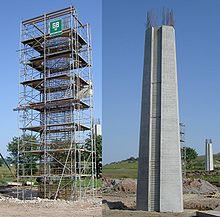
Back Gewapende beton Afrikaans خرسانة مسلحة Arabic Formigón armao AST Dəmir-beton Azerbaijani Тимер-бетон Bashkir Жалезабетон Byelorussian Жалезабэтон BE-X-OLD Стоманобетон Bulgarian রিইনফোর্সড কংক্রিট Bengali/Bangla Formigó armat Catalan
| Reinforced concrete | |
|---|---|
 A heavy, reinforced concrete column, seen before and after the concrete has been cast in place around its rebar frame | |
| Material type | Composite material |
| Mechanical properties | |
| Tensile strength (σt) | Stronger than concrete |
Reinforced concrete, also called ferroconcrete, is a composite material in which concrete's relatively low tensile strength and ductility are compensated for by the inclusion of reinforcement having higher tensile strength or ductility. The reinforcement is usually, though not necessarily, steel reinforcing bars (known as rebar) and is usually embedded passively in the concrete before the concrete sets. However, post-tensioning is also employed as a technique to reinforce the concrete. In terms of volume used annually, it is one of the most common engineering materials.[1][2] In corrosion engineering terms, when designed correctly, the alkalinity of the concrete protects the steel rebar from corrosion.[3]
- ^ "16 Materials Every Architect Needs to Know (And Where to Learn About Them)". ArchDaily. December 19, 2016. Archived from the original on July 9, 2021. Retrieved July 9, 2021.
- ^ Sarah (March 22, 2017). "When should you use reinforced concrete?". EKA Concrete | Direct Supplier of Ready Mix and Site Mix Concrete. Retrieved July 9, 2021.
- ^ Structural materials. George Weidmann, P. R. Lewis, Nick Reid, Open University. Materials Department. Milton Keynes, U.K.: Materials Dept., Open University. 1990. p. 360. ISBN 0-408-04658-9. OCLC 20693897.
{{cite book}}: CS1 maint: others (link)